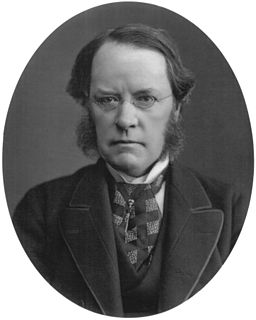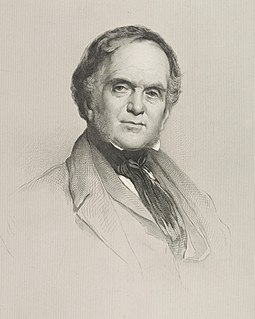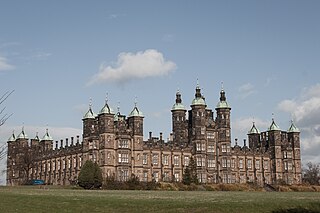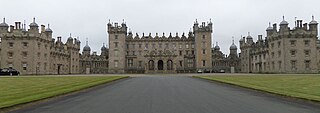
The Scottish National Gallery is the national art gallery of Scotland. It is located on The Mound in central Edinburgh, close to Princes Street. The building was designed in a neoclassical style by William Henry Playfair, and first opened to the public in 1859.

Lyon Playfair, 1st Baron Playfair was a British scientist and Liberal politician who was Postmaster-General from 1873 to 1874.

John Playfair FRSE, FRS was a Church of Scotland minister, remembered as a scientist and mathematician, and a professor of natural philosophy at the University of Edinburgh. He is best known for his book Illustrations of the Huttonian Theory of the Earth (1802), which summarised the work of James Hutton. It was through this book that Hutton's principle of uniformitarianism, later taken up by Charles Lyell, first reached a wide audience. Playfair's textbook Elements of Geometry made a brief expression of Euclid's parallel postulate known now as Playfair's axiom.

William Henry PlayfairFRSE was a prominent Scottish architect in the 19th century, who designed the Eastern, or Third, New Town and many of Edinburgh's neoclassical landmarks.
James, Jamie, Jim, or Jimmy Thomson may refer to:

The Royal Scottish Academy (RSA) is the country’s national academy of art. It promotes contemporary Scottish art.

William Playfair, a Scottish engineer and political economist, served as a secret agent on behalf of Great Britain during its war with France. The founder of graphical methods of statistics, Playfair invented several types of diagrams: in 1786 the line, area and bar chart of economic data, and in 1801 the pie chart and circle graph, used to show part-whole relations. As a secret agent, Playfair reported on the French Revolution and organized a clandestine counterfeiting operation in 1793 to collapse the French currency.

Donaldson's School, in Linlithgow is Scotland's national residential and day school, providing education, therapy and care for pupils who are deaf or who have communication difficulties.
The year 1831 in architecture involved some significant events.

Old College is a late 18th-century to early 19th-century building of the University of Edinburgh, Scotland. It is located on South Bridge, and presently houses parts of the University's administration, the University of Edinburgh School of Law, and the Talbot Rice Gallery.

James Playfair was a Scottish architect who worked largely in the neoclassical tradition.

Floors Castle, in Roxburghshire, south-east Scotland, is the seat of the Duke of Roxburghe. Despite its name it is an estate house rather than a fortress. It was built in the 1720s by the architect William Adam for Duke John, possibly incorporating an earlier tower house. In the 19th century it was embellished with turrets and battlements, designed by William Playfair, for The 6th Duke of Roxburghe. Floors has the common 18th-century layout of a main block with two symmetrical service wings. Floors Castle stands by the bank of the River Tweed and overlooks the Cheviot Hills to the south.

The Dugald Stewart Monument is a memorial to the Scottish philosopher Dugald Stewart (1753–1828). It is situated on Calton Hill overlooking the city of Edinburgh and was designed by Scottish architect William Henry Playfair.

The Old Calton Burial Ground is a cemetery in Edinburgh, Scotland. It located at Calton Hill to the north-east of the city centre. The burial ground was opened in 1718, and is the resting place of several notable Scots, including philosopher David Hume, scientist John Playfair, rival publishers William Blackwood and Archibald Constable, and clergyman Dr Robert Candlish. It is also the site of the Political Martyrs' Monument, an obelisk erected to the memory of a number of political reformers, and Scotland's American Civil War Memorial.
Events from the year 1857 in Scotland.
William Playfair was a Scottish engineer and political economist.
Playfair is an English surname which came to England after the Norman Conquest. The name derives from the Old French toponymic surname Plouvier and came from Plouvien, Brittany. Notable people with the surname include:
Events from the year 1794 in Scotland.

Carlton Terrace is a residential street in Edinburgh, Scotland. It is located on the east side of Calton Hill, at the eastern extremity of the New Town, part of the UNESCO World Heritage Site inscribed in 1995.
This page is based on this
Wikipedia article Text is available under the
CC BY-SA 4.0 license; additional terms may apply.
Images, videos and audio are available under their respective licenses.












